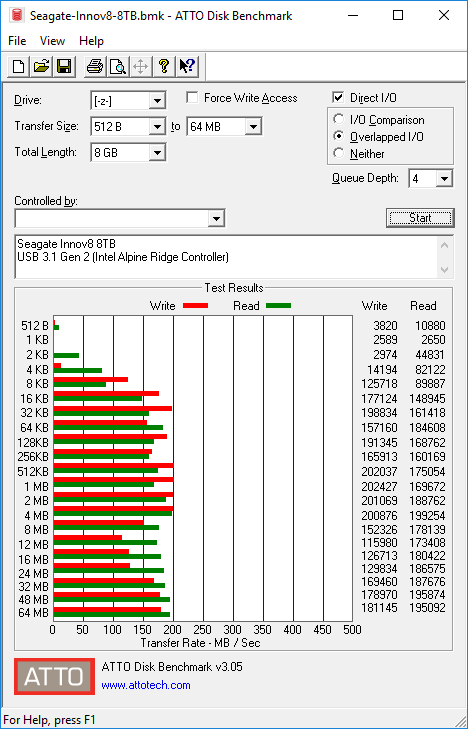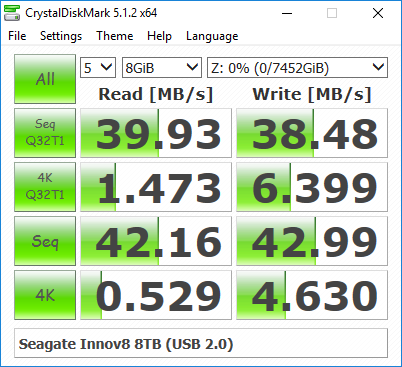Seagate Innov8 8TB Bus-Powered External Hard Drive Review
by Ganesh T S on May 19, 2016 8:30 AM ESTDirect-Attached Storage Benchmarks
The Seagate Innov8 comes pre-formatted in exFAT. We retained the file system along with the contents on it (setup programs for the Seagate Dashboard and a warranty document PDF) for benchmarking purposes. In order to evaluate the DAS aspect of the unit, we utilized the testbed outlined in the table below to test the performance. One of the USB 3.1 ports enabled by the Intel Alpine Ridge controller was used to connect the unit to the system.
| AnandTech DAS Testbed Configuration | |
| Motherboard | GIGABYTE Z170X-UD5 TH ATX |
| CPU | Intel Core i5-6600K |
| Memory | G.Skill Ripjaws 4 F4-2133C15-8GRR 32 GB ( 4x 8GB) DDR4-2133 @ 15-15-15-35 |
| OS Drive | Samsung SM951 MZVPV256 NVMe 256 GB |
| SATA Devices | Corsair Neutron XT SSD 480 GB Intel SSD 730 Series 480 GB |
| Add-on Card | None |
| Chassis | Cooler Master HAF XB EVO |
| PSU | Cooler Master V750 750 W |
| OS | Windows 10 Pro x64 |
| Thanks to Cooler Master, GIGABYTE, G.Skill and Intel for the build components | |
Our testing methodology for DAS units takes into consideration the usual use-case for such devices. The most common usage scenario is transfer of large amounts of photos and videos to and from the unit. The minor usage scenario is importing files directly off the DAS into a multimedia editing program such as Adobe Photoshop. Prior to taking a look at the real-life benchmarks, we first check what ATTO and CrystalDiskMark have to report for the Seagate Innov8. We see numbers around 200 MBps for sequential transfers, correlating well with Seagate's performance claims.
In order to tackle the first real-life use-case, we created three test folders with the following characteristics:
- Photos: 15.6 GB collection of 4320 photos (RAW as well as JPEGs) in 61 sub-folders
- Videos: 16.1 GB collection of 244 videos (MP4 as well as MOVs) in 6 sub-folders
- BR: 10.7 GB Blu-ray folder structure of the IDT Benchmark Blu-ray (the same that we use in our robocopy tests for NAS systems)
| Seagate Innov8 8TB robocopy Benchmarks (MBps) | ||
| Write Bandwidth | Read Bandwidth | |
| Photos | 41.81 | 29.22 |
| Videos | 76.81 | 92.11 |
| Blu-ray Folder | 100.23 | 116.91 |
These numbers show the unpredictable nature of the performance of the drive. It is not only the DRAM cache (that usually delivers predictable changes in performance beyond a certain amount of data), but, also the distributed media cache on the SMR drive that influence the write speeds. Reads are affected quite a bit if they happen to involve data that is currently being subject to 'garbage collection' - i.e, moving from one portion of the drive / cache to a more permanent location in the platters.
For the second use-case, we take advantage of PC Mark 8's storage bench. The storage workload involves games as well as multimedia editing applications. The command line version allows us to cherry-pick storage traces to run on a target drive. We chose the following traces.
- Adobe Photoshop (Light)
- Adobe Photoshop (Heavy)
- Adobe After Effects
- Adobe Illustrator
Usually, PC Mark 8 reports time to complete the trace, but the detailed log report has the read and write bandwidth figures which we present in our performance graphs. Note that the bandwidth number reported in the results don't involve idle time compression. Results might appear low, but that is part of the workload characteristic. This is not the intended use-case for external hard drives, but the results are just presented here for the sake of completeness.
| Seagate Innov8 8TB PCMark8 Storage Benchmarks (MBps) | ||
| Write Bandwidth | Read Bandwidth | |
| Adobe Photoshop (Light) | 73.13 | 3.92 |
| Adobe Photoshop (Heavy) | 94.87 | 5.21 |
| Adobe After Effects | 74.41 | 4.10 |
| Adobe Illustrator | 115.22 | 3.91 |
Seagate explicitly mentions that the Innov8 is not compatible with USB ports delivering less than 7.5W of power. Taking the safe route, they don't advertise compatibility with any Type-A ports. However, we got curious and decided to use a Type-A to Type-C USB 3.1 adapter cable and check with the other USB ports in our DAS testbed.
Surprisingly, even the USB 2.0 ports on the GIGABYTE motherboard in our testbed are able to supply the 7.5W minimum power required by the Innov8.
Our rough benchmarking (CrystalDiskMark only) with the USB 2.0 port shows that sequential transfers have no problems in saturating the USB 2.0 bandwidth.













41 Comments
View All Comments
osxandwindows - Thursday, May 19, 2016 - link
So, this is a buss powered desktop usb 3.0 drive?If I had a macbook with usb C, smh.
ddriver - Thursday, May 19, 2016 - link
An OPTIONAL power adapter would have been wise for systems which can't provide enough power.Haravikk - Monday, May 23, 2016 - link
Agreed. Do type-A to type-C adapters exist that have power injection? For example, if you buy a Power Over Ethernet device many come with power injectors in case your switches etc. can't provide it directly, something similar could work here.Or perhaps a type-C to 2x type-A cable? I've seen those used on some hard drive docks, allowing them to draw extra power from a power USB hub or computer, in cases where one connector doesn't provide enough.
I dunno, it's great to see type-C adoption, but personally I'd say that connectivity is too important for external drives at this transitional stage for there to be only be a single option, especially if the power requirement is going to make many adapters and even some type-C devices insufficient for these drives.
bananaforscale - Thursday, May 19, 2016 - link
Technically no, since Type C connectors are much newer than USB3.0.ImSpartacus - Thursday, May 19, 2016 - link
This is kind of neat. The integrated battery is a novel way to overcome design limitations.Samus - Thursday, May 19, 2016 - link
In a lot of ways I'm glad they didn't try a series of capacitors or a super cap, the battery is significantly more flexible in the long run, and should have a long service life (LiPo is at least 5 years if it keeps getting excercise)Very innovative Seagate. Sometimes you surprise me.
ddriver - Friday, May 20, 2016 - link
Yeah, it has only been used to start cars for at least half a century. Such innovation that the mind truly boggles...BurntMyBacon - Friday, May 20, 2016 - link
@ddriver: "Yeah, it has only been used to start cars for at least half a century."I'd like to see someone toting around "portable" HDDs with Lead-Acid start-up batteries. (0_0)
On a serious note, charge pumps, batteries, capacitors, and even super capacitors have been around for a long time. This implementation isn't new either, though it may be a first for USB Type-C and I haven't seen retail products using it up to this point.
extide - Monday, May 23, 2016 - link
Umm, no, LiPo batteries are not used to start cars, lead-acid batteries are. No need for LiPo in a car, lead acid batteries are better for the high current demands of starting an engine plus they are cheaper and the size and weight penalty is not an issue in a vehicle.ddriver - Monday, May 23, 2016 - link
Nitpickers - always missing the point. And the point was that if you need extra current to start you use a battery you subsequently charge. What kind of battery depends on the application doh.